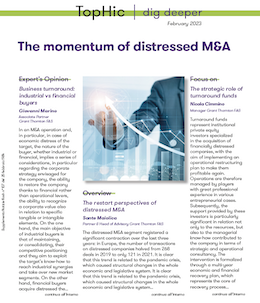-
Transactional advisory services
Find out more about the transactional advisory services of Grant Thornton Financial Advisory Services
-
Valuations
Find out more about the valuations services of Grant Thornton Financial Advisory Services
-
Mergers and acquisitions
Find out more about the merger and acquisition services of Grant Thornton Financial Advisory Services
-
Forensic and investigation services
Find out more about the forensic and investigation services of Grant Thornton Financial Advisory Services
-
Recovery & reorganisation
Find out more about the Recovery & reorganisation services of Grant Thornton Financial Advisory Services
-
Business risk services
Find out more about the business risk services of Grant Thornton Financial Advisory Services
-
Business consulting
Find out more about the business consulting services of Grant Thornton Financial Advisory Services
-
Capital market
Capital market
-
Corporate and business tax
Find out more about our corporate and business tax services.
-
Direct international tax
Find out more about our direct international tax services.
-
Global mobility services
Find out more about our global mobility services.
-
Indirect international tax
Find out more about our indirect international tax services.
-
Transfer pricing
Find out more about our transfer pricing services.
-
Litigation
Our lawyers and accountants can manage all defense measures provided not only by the Italian law, but also by EU regulations and conventions
-
Family business
Find out more about our Family business services.
-
Legal
The client can be assisted in every need and with the same care both on important operations or disputes and on simple matters

-
Back office outsourcing
Find out more about our Back office outsourcing services
-
Business process outsourcing
Find out more about our business process outsourcing services.
-
Compilation of financial statements
Find out more about our compilation of financial statements services.
-
Tax compliance
Find out more about our tax compliance services.
-
Electronic invoicing
Find out more about our electronic invoicing services
-
Electronic storage
Electronic storage is an archiving procedure that guarantees the legal validity of a digitally stored electronic document
-
Revaluation of corporate assets
Find out your civil and fiscal revaluation of tangible, intangible and financial assets
-
Payroll
Complete and customized payroll service, integrated with digital solutions and compliant with Italian and international regulations.
-
Labor consultancy
We help Italian and international companies manage all aspects of their workforce.
-
HR & Payroll Advisory Services
We review contracts, payroll, and risks for extraordinary transactions and we assess tax, labor, and safety risks in outsourcing contracts.
-
Extended services
We provide integrated digital tools to simplify HR management.
-
HR Infinity Portal
The HR Infinity Portal is Zucchetti’s platform designed to centralize communication between the company and its employees.
-
Cybersecurity
GT Digital helps clients structure information security management internal functions, also through partially or totally outsourced functions
-
Agile and Programme Management
GT Digital provides support in the adoption and implementation of different portfolio management
-
Robotic Process Automation
Our “BOT Farm” can rely on digital workers able to help clients in routine activities, allowing employees to deal with more added-value activities
-
Data strategy and management
GT Digital can support clients in seizing the opportunities offered by Big Data, from the definition of strategies to the implementation of systems
-
Enterprise Resource Planning
We support clients in selecting the most appropriate ERP System according to their specific needs, helping them also understand licensing models
-
IT strategy
GT Digital supports clients in making strategic choices, identifying innovation opportunities, comparing themselves with competitors
-
IT service management
We can support with software selection and with the implementation of dedicated tools for the management of ICT processes
-
DORA and NIS 2
The entry into force of the DORA Regulation and NIS2 represents a major step towards the creation of a harmonised regulatory framework
In an M&A operation and, in particular, in case of economic distress of the target, the nature of the buyer, whether industrial or financial, implies a series of considerations, in particular regarding the corporate strategy envisaged for the company, the ability to restore the company thanks to financial rather than operational levers, the ability to recognize a corporate value also in relation to specific tangible or intangible elements.
On the one hand, the main objective of industrial buyers is that of maintaining, or consolidating, their competitive positioning and they aim to exploit the target's know-how to reach industrial synergies and take over new market segments.
On the other hand, financial buyers acquire distressed companies with the aim of realizing the investment in the exit phase, exploiting the value increase created by the implemented recovery plan. In general, industrial players prefer the total purchase of the target, without disclosing the future strategies for the company, while financial players prefer majority acquisitions, but allowing the management to participate in the project.
With specific reference to the distressed M&A market, the trend of recent years shows how industrial buyers were predominant: in 2019, 6 deals out of 10 were promoted by strategic buyers, representing more than 60% of the market. On the other hand, the current picture shows a clear turnaround in the market in favour of financial buyers, which represented 67% of the market in 2021 and more than 80% in 2022.

This sudden turnaround is certainly due to the changed economic and financial framework: in fact, strategic buyers are interested in distressed M&A operations in similar industries and, therefore, there are clear limits to the implementation of consolidation or combination projects due to the general uncertainty generated by the pandemic crisis and the changed geopolitical context.
Therefore, the same strategic buyers’ shareholders, which are usually less willing to risk than financial operators, have chosen to wait for a more favourable economic situation to seize opportunities in this sense. Conversely, financial buyers, thanks to the high liquidity available on financial markets and to the opportunities related to the huge sale of so-called non-performing loans promoted by banks, were able to exploit the distressed M&A market more easily. In fact, the same financial players were able to objectively read the risk-return ratio of the distress operation and seize market opportunities.
A growing trend in the number of distressed M&A transactions is expected in the coming months, due, on the one hand, to a further consolidation of financial buyers, thanks to the aforementioned available liquidity, and, on the other hand, to a great restart of those deals promoted by industrial partners, which were previously frozen due to a wait-and-see strategic approach of shareholders.

